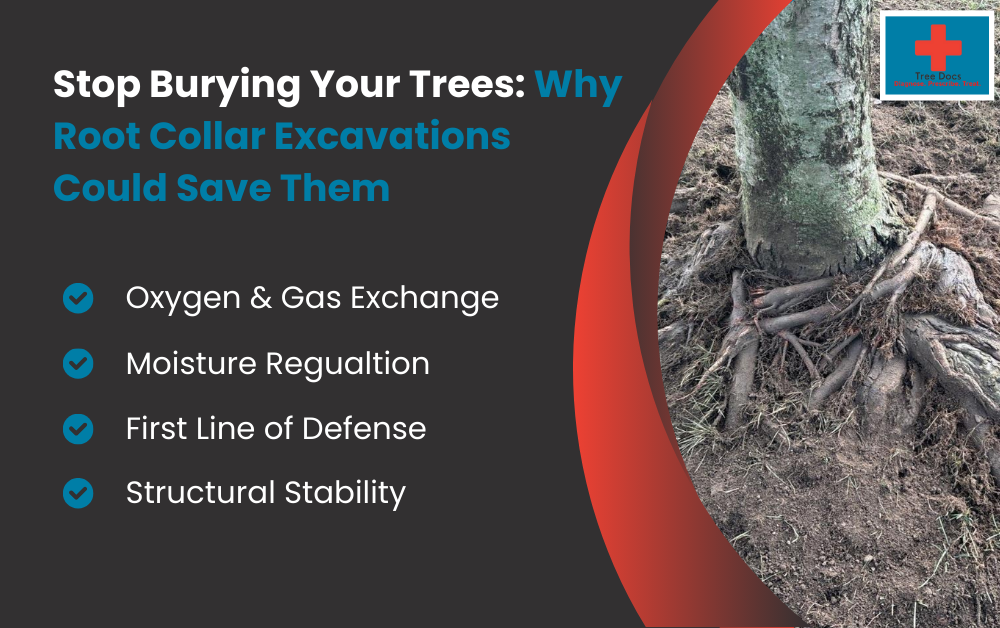Spring cleanups are a great way to give your yard a fresh start—edges get sharpened, beds get refreshed, and mulch is piled neatly around trees. But there’s a hidden danger in all that tidying up:
Excess soil and mulch could be silently killing your trees.
It’s one of the most common landscaping mistakes: burying the base of the tree, also known as the root collar. Over time, this seemingly harmless issue can lead to rot, pest infestations, girdling roots, and even catastrophic tree failure.
What Is the Root Collar and Why Is It So Important?
The root collar (or root flare) is the part of a tree where the trunk widens and transitions into the root system. On a healthy tree, you should be able to see this flare at the soil line—it’s a sign the tree is properly planted and breathing well.
This area is crucial for several reasons:
🌳 Oxygen and Gas Exchange
The root collar allows gases to flow between the tree and the soil. Burying it in mulch or dirt restricts oxygen flow to the roots and stresses the tree.
💧 Moisture Regulation
The bark at the trunk isn’t meant to stay wet. When soil or mulch is packed around the root collar, it holds moisture against the bark, leading to decay, fungal infections, and pest infestations.
🦠 First Line of Defense
Pests like ambrosia beetles and pathogens like Armillaria root rot love the warm, moist, hidden environment a buried root collar creates.
🛠️ Structural Stability
This is where the trunk connects to the root system—essentially the foundation of the tree. If this area is compromised, the tree can fail from the base, which is far more dangerous than losing a limb. Base failures are sudden, and can bring down an entire tree in a single storm.
What Happens When the Root Flare Gets Buried?
Whether it’s from leftover soil during edging or too much mulch around the trunk, burying the root collar causes a host of problems:
- Traps moisture against bark, leading to rot
- Encourages fungal infections like Armillaria and Phytophthora
- Attracts pests like wood borers and ambrosia beetles
- Hides girdling roots that can slowly strangle the tree
- Compromises structural stability, increasing risk of total failure
Warning Signs to Watch For
Not sure if your trees are in trouble? Keep an eye out for these red flags, especially near the base:
- 🚫 No visible root flare – The trunk goes straight into the ground like a telephone pole
- 🍂 Dieback from the top down – Thinning canopy or branch death starting at the top
- 🌳 Swollen or lumpy base – Often a sign of internal pressure from girdling roots
- 🪵 Cracking or peeling bark at the base – Indicates decay or root collar stress
- 🧱 Flat-sided trunk – Suggests something is pushing against the inside of the tree (usually roots)
- 🍄 Mushrooms or fungal growth near the base – A big red flag for rot
If you notice one or more of these, it’s time to take action.
Girdling Roots: The Hidden Threat
Girdling roots are roots that grow in a circular pattern around the trunk instead of outward. Over time, they begin to choke the tree—cutting off the flow of water and nutrients and weakening the trunk from within.
These are especially common in trees that were:
- Planted too deeply
- Heavily mulched over many seasons
- Grown in containers before planting
Since girdling roots develop underground, they often go undetected until the tree starts declining or fails completely.
What is a Root Collar Excavation (RCE)?
A Root Collar Excavation is a professional procedure that removes excess soil and mulch from around the base of the tree, usually using a gentle air excavation tool (like an AirSpade). This allows arborists to:
- Expose the natural root flare
- Identify girdling roots
- Check for decay, pests, and disease
- Restore proper airflow and moisture balance
- Take corrective actions before major decline sets in
Think of it as a tree health check-up—one that could prevent serious, costly damage down the road.
What You Can Do as a Homeowner
- ✅ Keep mulch 2–3 inches deep, and pull it 3–6 inches away from the trunk
- 👀 Look for the root flare—you should always be able to see it
- 🧑🌾 Talk to your landscapers—make sure they’re not burying the base during spring cleanups
- 🌲 Have a certified arborist inspect your trees—especially if symptoms have already appeared
- 🔍 Schedule a Root Collar Excavation if you suspect problems or haven’t seen your tree’s flare in years
Final Thoughts
Trees add beauty, shade, and value to your home—but they also depend on us to protect their health, especially during seasonal maintenance. By paying attention to the root collar, you can prevent many of the most serious threats to tree health before they start.
So this spring, after your cleanup crew leaves, do a quick check: Can you see the base of your tree widening into the ground? If not, it might be time for a root collar excavation.
Your tree will thank you—with years of strong, healthy growth.
Need Help? Call Tree Docs.
If you’re not sure whether your trees are at risk or you suspect buried root collars, Tree Docs is here to help. Our certified arborists specialize in root collar excavations and proactive tree care. Contact us today to schedule an evaluation and give your trees the support they need to thrive.



